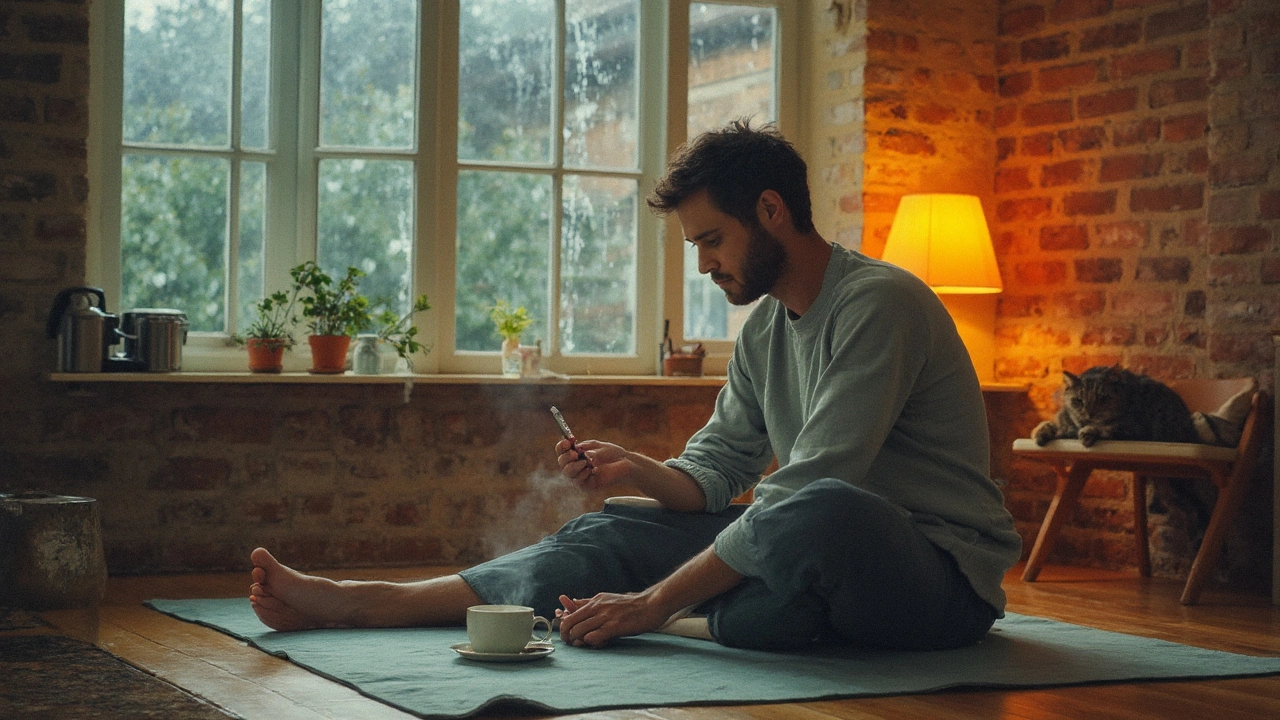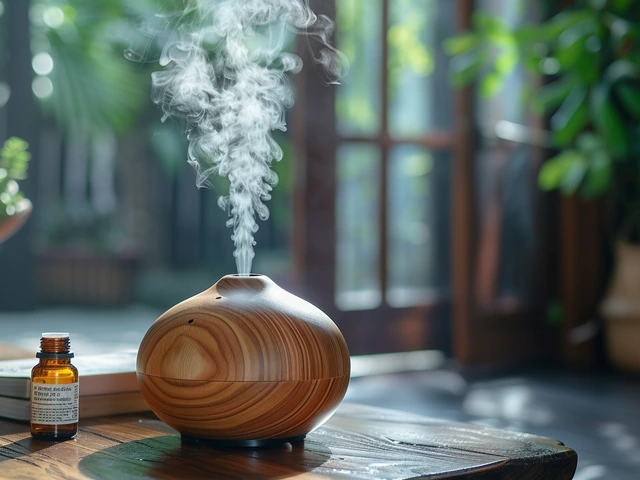Stress isn’t just a feeling; it’s a full-body chain reaction. If your mind keeps racing, your heart pounds, and sleep feels broken, the fix isn’t “try to relax.” The fix is learning which switches in your body control the stress response and how to nudge them-reliably, in minutes. This guide translates lab science into steps you can use today, without magic or mystery.
- TL;DR / Key takeaways
- Stress runs through two main systems: the fast fight-or-flight (sympathetic) and the slower hormone loop (HPA axis and cortisol). Chronic stress is the gas pedal stuck down; our goal is to train the brakes.
- Proven tools: slow breathing at ~6 breaths/min, mindfulness training (8 weeks works well), 150 minutes/week of moderate exercise, consistent sleep timing, sunlight and social connection. Each targets a different lever: vagus nerve tone, threat perception, and cortisol rhythms.
- Quick-start: 5 minutes of slow breathing before tough tasks, 20-30 minutes of movement most days, a phone-free wind-down routine, and one meaningful conversation daily. Track progress with a 1-minute weekly stress score (PSS-4) and sleep consistency.
- Expect first benefits in minutes (breathing), days (walking), and weeks (mindfulness, sleep regularity). If panic, depression, or impairment lasts beyond two weeks, loop in a clinician.
What Stress Does to Your Body (and Why It’s Reducible)
Here’s the fast tour of anatomy. When your brain detects a threat-deadlines count-the sympathetic nervous system floods your body with adrenaline. Your heart rate jumps, muscles tense, and attention narrows. A second system, the hypothalamic-pituitary-adrenal (HPA) axis, releases cortisol. Cortisol helps you mobilize fuel and stay alert, then should drop later in the day. Under chronic pressure, cortisol can stay elevated or flatten at the wrong times, which is linked to fatigue, brain fog, and poor sleep.
Think of it as pedals and steering. Sympathetic is the gas. Parasympathetic is the brake, mostly via the vagus nerve, which slows heart rate and supports digestion. You can train that brake-this is not willpower, it’s physiology. Slow breathing and certain movements signal safety through the vagus nerve, shifting your system from high alert to “it’s okay.”
Long-term wear and tear from being revved too high is called allostatic load. Neuroscientist Bruce McEwen popularized this concept decades ago, and the evidence since has piled up: chronic stress reshapes brain circuits involved in focus and emotion, but those changes are plastic. They can shift back with targeted practices and time.
Here’s the bit most people miss: stress isn’t the enemy. Stuck stress is. Acute stress can sharpen you; recovery cements the gains. You’re not trying to erase stress-you’re building a responsive system that surges when needed and settles fast afterward.
What does the research say (without the jargon)?
- Breath control at ~6 breaths per minute increases heart-rate variability (HRV), a marker of parasympathetic activity, within minutes. A 2017 meta-analysis in Frontiers in Psychology reported moderate reductions in stress and anxiety with HRV biofeedback.
- Mindfulness-based programs (like MBSR) reliably reduce perceived stress and symptoms of anxiety and depression. A 2014 JAMA Internal Medicine review found small-to-moderate improvements across these outcomes with 8-week programs.
- Regular aerobic exercise (brisk walking counts) lowers trait anxiety and improves mood; position stands from the American College of Sports Medicine and multiple meta-analyses support 150 minutes/week for meaningful benefits.
- Nature exposure drops physiological stress markers. A 2019 study in Frontiers in Psychology found that 20-30 minutes in green spaces reduced cortisol levels significantly in urban adults.
- Sleep regularity (same wake-up time daily) improves stress tolerance by stabilizing circadian rhythms that drive cortisol. Clinical sleep guidelines and randomized trials point to consistent, earlier light exposure amplifying the effect.
The takeaway: your biology gives you multiple “handles” to turn stress down. Use more than one; they stack.

What Works: Evidence-Backed Ways to Turn the Dial Down
Let’s turn science into a plan you can actually follow-even on busy weeks. Pick one fast-acting tool for immediate relief and one habit for durable change. Then layer as needed.
Fast-acting tools (minutes):
- Six-per-minute breathing. Inhale 4 seconds, exhale 6 seconds, for 5 minutes. Longer exhales nudge the vagus nerve. Use it before presentations, during conflict, or when your mind spins. Evidence: HRV biofeedback literature shows quick reductions in physiological arousal.
- Physiological sigh. Two short inhales through the nose, one long exhale through the mouth, for 1-2 minutes. This offloads carbon dioxide and can soften panic peaks. Backed by respiratory physiology studies on CO2 regulation.
- 30-90 seconds of muscle release. Unclench jaw, drop shoulders, open hands, exhale slowly. Your brain reads posture as “threat” or “safety,” so the signal matters.
Habit builders (days to weeks):
- Mindfulness practice, 10-20 minutes/day. Choose guided body scan or breath focus. Eight-week programs reliably improve perceived stress. A 2014 JAMA Internal Medicine review and later updates show small-to-moderate effects; consistency beats length.
- Movement routine: 150 minutes/week moderate (like brisk walking) or 75 minutes vigorous, plus 2 strength sessions. For mood, spread it across the week; even 10-minute brisk walks help. Exercise dampens amygdala reactivity and improves sleep-two birds.
- Sleep anchors: fixed wake time, outdoor light within an hour of waking, phones out of the bedroom, and a 30-60 minute wind-down. Expect stress tolerance to rise within 7-14 days as your circadian rhythm stabilizes.
- Social buffering: one meaningful 10-minute conversation daily. Warm social contact reduces cortisol and calms threat networks. Quality beats quantity.
- Nature micro-doses: 20 minutes in a park 3-4 times a week. If you can’t, window light and potted plants still help. Add a short walk to double the effect.
- Caffeine timing: cut off 8-10 hours before bedtime. Caffeine blocks adenosine and can keep the stress system “sticky.” Reduce gradually to avoid withdrawal headaches.
Practical protocols you can start today:
- 2-20-2 Rule (daily): 2 minutes slow breathing on waking, 20-30 minutes of movement anytime, 2 minutes slow breathing before bed.
- 3-2-1 Sleep Wind-Down: stop work 3 hours before bed, food 2 hours before, screens 1 hour before (swap for a shower, stretch, or book).
- Red Flag Reset: if you feel tunnel vision and shallow breathing, step away for 90 seconds, do 10 slow breaths, and do one mundane task (dishes, sorting) to re-engage the thinking brain.
Food and stress-keep it simple:
- Protein + fiber at each meal to steady blood sugar-sharp swings can mimic anxiety.
- Hydrate earlier in the day. Even mild dehydration raises heart rate and perceived effort.
- Alcohol might feel relaxing, but it fragments sleep and spikes next-day stress hormones. Save it for weekends, early evening, and limit to one drink.
Supplements? Proceed with caution and a clinician:
- Magnesium glycinate (200-400 mg at night) can support sleep quality in some adults. Evidence is mixed; check kidney health and meds.
- L-theanine (100-200 mg) may promote calm without sedation; small randomized trials suggest benefit.
- Ashwagandha has trials showing reduced perceived stress, but quality varies; discuss with a healthcare professional, especially if pregnant, on thyroid meds, or with autoimmune conditions.
Below is a compact view of what works, how much, and how fast to expect results.
| Technique | Primary mechanism | Typical dose | Time to benefit | Evidence snapshot | Best for |
|---|---|---|---|---|---|
| 6-breaths-per-minute breathing | Vagus activation; increases HRV | 5-10 min, 1-3x/day | Minutes | Meta-analyses show moderate stress/anxiety reduction | Acute spikes; pre-meeting calm |
| Mindfulness (MBSR/body scan) | Rewires attention; lowers threat reactivity | 10-20 min/day, 8 weeks | 2-8 weeks | JAMA Internal Medicine review: small-moderate effects | Racing thoughts; rumination |
| Brisk walking/jogging | Downshifts amygdala; improves sleep | 150 min/week moderate | Days-weeks | Exercise guidelines and meta-analyses support mood and stress benefits | Daytime tension; low mood |
| Strength training | Hormonal balance; resilience | 2 sessions/week | Weeks | Randomized trials show reduced anxiety/stress | Confidence; sleep depth |
| Nature exposure | Visual/biophilic calm; cortisol drop | 20-30 min, 3-4x/week | Minutes-days | Urban adult studies show significant cortisol reduction | Screen fatigue; urban stress |
| Sleep regularity | Stabilizes cortisol rhythm | Fixed wake time; 7-9 hours | 7-14 days | Clinical sleep research links regularity to stress tolerance | Morning anxiety; brain fog |
Credible sources behind these: JAMA Internal Medicine (2014) on mindfulness programs, Frontiers in Psychology (2017) on HRV biofeedback, position statements from the American College of Sports Medicine, and trials in sleep medicine and environmental psychology.
Common pitfalls to avoid:
- Doing one giant session on Sunday and nothing all week. Frequency beats intensity for stress.
- Breathing too fast or holding breath. Aim for slow, comfortable exhalations; dizziness means you’re overdoing it.
- Starting meditation in the middle of a panic surge. Use breath or a short walk first; then sit when arousal drops a notch.
- Drinking coffee on an empty stomach, then wondering why your hands shake.
- Using alcohol to “relax” nightly and sabotaging sleep.
Cheat sheet (print this if you like):
- Morning: light outside + 2 minutes slow breathing
- Day: one 10-20 minute walk or workout
- Evening: phone out of the bedroom + 2 minutes slow breathing
- Anytime: one meaningful conversation (call a friend, talk with a partner)
Keep It Working: Tracking, FAQs, and Next Steps
You don’t need a lab to know it’s working. Track what your body actually feels and does. Two minutes per week is enough.
Simple tracking that works in real life:
- PSS-4 (Perceived Stress Scale-short form). Four questions once a week. Aim for a downward trend over 3-4 weeks.
- Sleep regularity. Same wake time daily ±30 minutes. Note daytime sleepiness and how often you hit the snooze button.
- Morning vitals. Resting heart rate (RHR) a few times a week; watch for a gradual drop of 2-5 bpm across a month if you’re consistent. HRV, if you track it, should trend up.
- Trigger log. Note top 2 triggers and what helped. Patterns appear fast-maybe it’s 3 pm emails or late caffeine.
Decision guide-what to use, when:
- If your heart is pounding right now: 5 minutes of 4-second in, 6-second out breathing. Repeat in an hour.
- If your mind is looping at night: 3-2-1 wind-down tonight; fix wake time tomorrow.
- If you feel wired and tired by mid-afternoon: short walk outside + water + light snack with protein.
- If you feel flat or irritable most days: commit to a 20-minute daily walk for 10 days before judging anything else.
- If meditation makes you more anxious: try mindful walking or body scans lying down; keep eyes open; start at 3-5 minutes.
Mini-FAQ
How long until this helps? Breathwork works in minutes. A week of daily walks and earlier light helps most people feel less on edge. Eight weeks of mindfulness practice moves the needle on trait stress. Sleep regularity can shift mood and energy within 7-14 days.
Can I just breathe and skip the rest? Use breathing for quick relief, but pair it with one habit (movement or sleep regularity) for durable change. Different levers work on different parts of the system; stacking multiplies benefits.
Is stress always bad? No. Acute stress can sharpen focus and performance. The key is the recovery after. If you can downshift quickly, stress becomes training, not wear and tear.
Which breathing pattern is best? One you’ll do. Many benefit from 4-6 second inhales and 6-8 second exhales. If you get lightheaded, shorten it. If nasal breathing is tough, check congestion or try a gentle warm-up.
What about cold exposure or sauna? Some people feel calmer afterward, likely through endorphins and a rebound parasympathetic response. Start mild, be safe (no fainting risk), and view these as optional add-ons, not core tools.
Do supplements help? Some can, but they’re not first-line and can interact with meds. Magnesium glycinate and L-theanine have modest evidence for calming effects; ashwagandha has supportive trials but isn’t for everyone. Talk to a clinician.
When should I get professional help? If panic, depression, sleep loss, or impairment persist beyond two weeks; if you have thoughts of self-harm; or if stress is tied to trauma that keeps intruding. Cognitive behavioral therapy, mindfulness-based therapies, and sometimes medications are evidence-backed and effective. Primary care can be a good first stop.
Next steps by scenario
- Student on deadlines: do 5 minutes of breathing before study blocks; use 25/5 focus sprints; walk around the building after two sprints; keep caffeine before 2 pm.
- Parent with no spare time: pair breathing with routines-2 minutes during kids’ bath or after school drop-off; stroller walks count as exercise; lights down and phones out 1 hour before your bedtime.
- Shift worker: prioritize consistency within your shift pattern; wear sunglasses on the commute home; use a 20-minute wind-down in a darkened room; nap earlier in the day, not close to “night” sleep.
- Manager glued to meetings: block a 10-minute walking meeting or hallway lap; start big calls with two quiet breaths; schedule a no-meeting 30-minute movement block 3 days a week.
- Athlete/high exerciser: keep the movement, add 5 minutes of breathing post-training; guard 7-9 hours of sleep; watch RHR/HRV for recovery rather than pushing harder.
Troubleshooting
- “Breathing doesn’t work for me.” Try a metronome app or music with a 10-second phrase; extend exhales gradually. Or try humming-vibration stimulates the vagus nerve.
- “I can’t sit still to meditate.” Do mindful walking: 10 minutes paying attention to the feeling of your feet and breath. Start there before seated practice.
- “I wake at 3 am, wide awake.” Keep the room dark, avoid screens, and try 5 minutes of slow breathing. If awake >20 minutes, read a paper book in low light. Protect the same wake time the next morning.
- “Exercise makes me more keyed up at night.” Move earlier in the day or keep evenings lower intensity (walks, light strength, yoga). Add a warm shower afterward to cue wind-down.
- “My schedule is chaotic.” Anchor just two things: wake time and 5 minutes of breathing. Build from there.
If you want one metric to watch this month, choose sleep regularity. It stabilizes cortisol, amplifies the benefits of breathing and exercise, and makes the rest easier.
Finally, remember why this matters: you’re not chasing a vibe. You’re training a system. With a few repeatable cues, your body learns to shift out of high alert faster. That’s the science behind stress reduction-and the art of making it stick.





